A leaking roof at any time of year is an absolute nightmare, let alone during autumn and winter months when, in the UK, it typically rains for most of that time.
Fortunately, if you have a leaking flat roof, this is often easier to repair than a sloping roof, so read on to find out exactly how.
Finding the Source of Leaks in a Flat Roof
The very first job to do before any repairs take place is to actually find the source of the leak. With a flat roof this is generally pretty straight forward, certainly much more so that a sloping or pitched roof.
From inside, identify any resulting damp spots that have been caused by the leak e.g. damp patches, mould growth on the ceiling and the likes.
Using a tape measure, measure the location of the damp/mould on the ceiling in relation to the nearest external walls.
Next, get up on the roof using a suitable ladder ensuring it’s stable (see here for ladder safety information) and measure the correct location of the internal damp to give you an idea of where the leak may be.
Clean away any debris etc. if there is any and inspect the area carefully until you identify the cause.
If it’s not absolutely obvious, get a bucket of water and gently pour it over the suspect areas and have someone inside tell you when they can see the resulting water leaking through, this will help to pin-point the problem area.
Types of Flat Roof Covering
In the UK there are quite a few different types of finish used to cover a flat roof and quite often, the repair method that is used will be quite specific to the type of finish that needs to be repaired.
The most common types of UK flat roof covering are as follows:
Felt Roofing (Torch-On Felt)
Felt roofing is one of the most traditional and widely used flat roof coverings in the UK.
It consists of layers of bitumen felt sheets bonded together using a hot torch and also usually a bitumen-based bond e.g. bitumen paint or the similar. This method creates a waterproof barrier that can last up to 20 years with proper maintenance.
Felt roofing is a budget-friendly option and is ideal for smaller projects like garden sheds, garages, and small extensions. It’s ideal for those on a budget wanting an easy to install covering and also ease of repair.
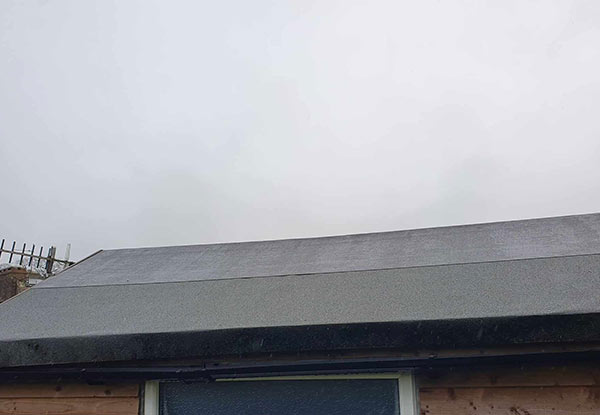
Felt rolls used to cover shed roof
EPDM Rubber Roofing
EPDM rubber roofing is a popular choice in the UK due to its long durability and weather resistance.
Made from a synthetic rubber membrane, EPDM can withstand very harsh weather conditions, such as heavy rain, frost, and UV exposure, making it perfect for the UK’s alternating climate.
It’s typically installed as a single sheet, reducing the risk of leaks, but can be joined fairly easily in the event of large coverings.
The EPDM rubber that is used is both lightweight, easy to install, and requires minimal maintenance, making it a great solution for both residential and commercial flat roofs.
In the event of damage it can also be easily patched and repaired.
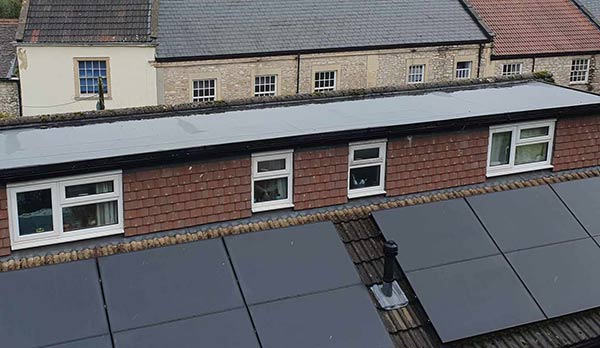
EPDM rubber used on dormer loft conversion roof
GRP Fibreglass Roofing
GRP (Glass Reinforced Plastic), or fibreglass roofing, is known for its seamless finish and exceptional lasting durability.
In the UK, it’s a popular choice for flat roofs that require a long-lasting, maintenance-free solution.
The GRP covering is applied as a liquid resin with a fibreglass matting layer, forming a tough, solid, waterproof surface once it has cured.
It is also highly resistant to cracking and can last up to and over 25 years.
This flat roof covering is ideal for all types of extensions, garages, balconies and the similar.
On the whole it offers a seamless, very sleek, modern appearance that complements pretty much any type of UK home.
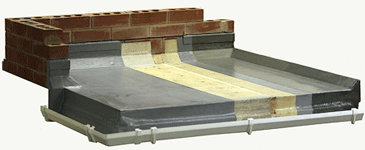
Reinforced fibreglass roof sheeting
Bitumen/Asphalt
Bitumen or asphalt roofing as it’s also known is, in a way, a little similar to the above felt roofing, however, rather than coming in sheets that are rolled out and stuck down, it comes in a pourable liquid that is spread over the area to be covered.
Once it has then hardened off and cured it forms a tough, solid, water tight covering suitable for pretty much all surfaces that can, if maintained correctly, last a good 20 years or more.
The one drawback that any bitumen/asphalt covering such as this has is that it can be susceptible to UV damage, but this is often countered by covering the liquid with gravel/stone that then bonds with the material once it cures, protecting it from the harmful UV rays.
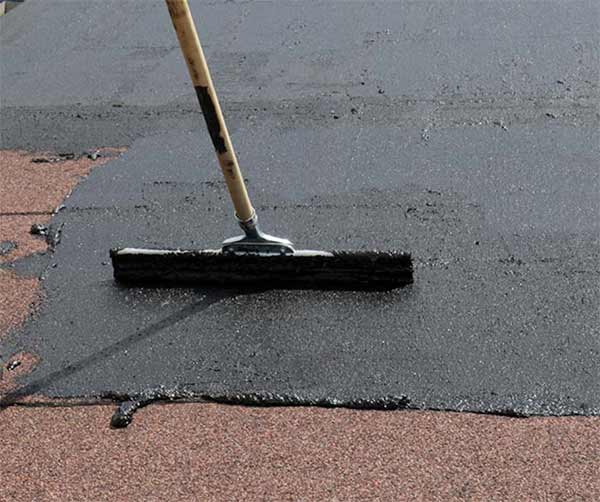
Bitumen/asphalt roofing being spread over surface
Green Roofs
Green roofs are an eco-friendly flat roof covering, becoming increasingly popular in urban UK areas.
A green roof is essentially a living roof, where vegetation such as grass, sedum, or wildflowers are planted on a waterproof membrane, that then creates the roof covering.
Green roofs provide excellent insulation, reduce rainwater runoff, and improve air quality.
One slight drawback is that they do require a higher upfront investment and some ongoing maintenance, but despite this the environmental benefits and aesthetic appeal make them a sustainable choice for homeowners looking to enhance their property’s value and contribution to helping the environment.
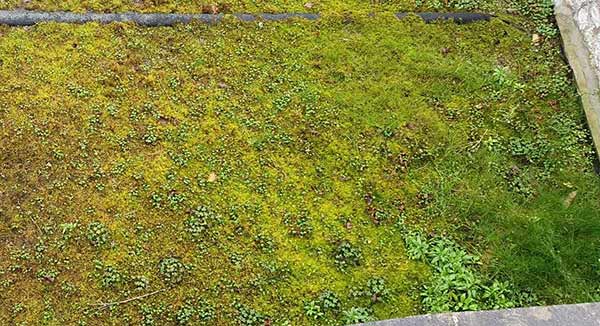
Green roof on top of garage
How to Repair Different Types of Flat Roof Covering in the UK
Regardless of the type of roof covering you have, unfortunately they will all be subject to wear and tear over time and when this happens, your best option is to make a repair, unless you have the funds available for a total replacement.
Depending on the type of flat roof material you have will depend on how it is repaired. Below we have detailed how each type can be made good to prevent any further leaks or other associated issues.
Repairing Felt Flat Roofs
Felt roofs, commonly used on sheds, garages and extensions can develop cracks, blisters or tears due to age, weather and UV exposure. To repair a felt roof:
- First, identify the exact site of the damage and clean the area thoroughly with a stiff brush to remove debris and dirt.
- If the felt is cracked or perished apply a cold bitumen adhesive to the damaged area, one popular option is Everbuild’s Black Jack and then cut a patch from some spare felt and then press it over the damaged area. Use a roller to ensure the patch is flat and secure.
- For larger tears, cut away the damaged section, insert a replacement piece of felt, and seal the edges with bitumen adhesive or a heat torch to create a watertight finish.
Regular maintenance can prevent further damage, so check your felt roof periodically, especially after storms.
Repairing EPDM Rubber Roofs
EPDM rubber roofing is durable, but despite this it can still suffer from punctures by sharp objects or seam separation over time. Here’s how to fix it:
- Identify the exact area of the leak and then clean the affected area thoroughly with a brush then a good quality rubber cleaner and then dry it thoroughly to ensure proper adhesion.
- Using a spare pice of EPDM rubber to make a patch and a good quality EPDM primer, apply the primer all around the puncture or tear, being generous and then apply the patch over the adhesive. Smooth the patch using a roller to remove air bubbles.
- If the seam has separated, clean everything thoroughly and apply a rubber adhesive along the seam and press it back together firmly using a roller.
- For added security you can then also apply a patch over the seam if you wish, but the seam repair itself should be more than sufficient.
EPDM repairs are straightforward, but using the correct, quality materials ensures a long-lasting fix.
Repairing GRP Fibreglass Roofs
GRP fibreglass roofs, although known for their durability, can unfortunately crack or suffer surface damage over time. To repair a fibreglass flat roof:
- Locate the source of the damage and clean the area thoroughly. Next, sand down the damaged area with coarse sandpaper to create a smooth surface and a good key for the repair.
- Mix up a fibreglass resin and hardener solution and apply it generously to the damaged area using a brush. Once cured, it will then form a water tight seal.
- For larger cracks, place a fibreglass mat over the resin and apply another generous layer on top.
- Allow the resin to cure and then sand it smooth and finish with a matching topcoat for a seamless, invisible repair.
GRP repairs require precision and the correct, good quality materials for a successful lasting repair, but once done, the result should once more be a durable and weatherproof roof.
Repairing Green Roofs
Green roofs are unique and eco-friendly means of forming a roof covering, but like all roofs leaks can occur if the waterproof membrane under the foliage is damaged. Repairing a green roof involves the following steps:
- Due to the coverage of the roofs surface, identifying the exact area of the damage can be tricky. The easiest method is to spot the damage on the inside, measure out to the nearest external walls, then transfer those measurements onto the top of the roof for the rough location.
- Once roughly located, carefully remove the vegetation and soil layers around the damaged area and pin point it exactly.
- Thoroughly clean and dry the entire area around the damage, ensuring it’s totally free from soil and moisture.
- The repair itself is done very much like an EPDM roof, where an EPDM, plastic or similar patch is applied over the damage and stuck down and sealed using a good quality adhesive to match the type of repair material being used.
- Once fully cured, reinstate the soil and vegetation layers over the repair and all should now be complete.
To prevent further issues, regularly inspect the quality of the membrane layer on the roof and also the interior area for any signs of leaks or the similar.
Emergency Flat Roof Repairs
In the event that you are unable to get a lasting repair in place right away, but you need to get something in place asap to stop a leak, many products have now arrived on the market to do just this.
Pretty much all of these come in a quick drying liquid form and simply require painting on over the affected area, where they then quickly cure creating a water tight seal over the damaged area.
As mentioned, there are many of these products available and a good selection can often be found in most high street DIY stores. A good example that we have used in the past is the Permaroof Emergency Roof Repair as seen below.
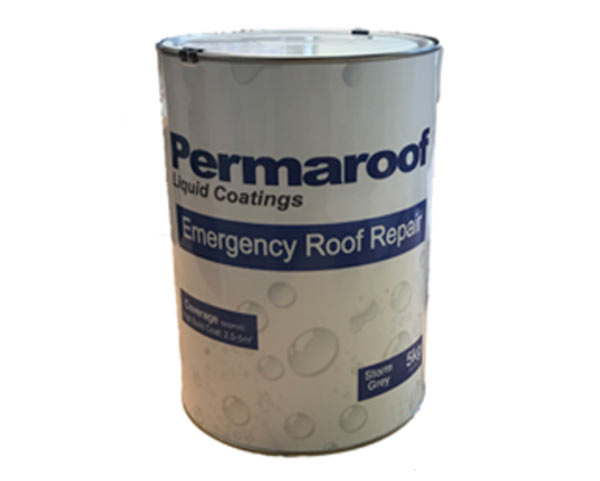
Permaroof Emergency Roof Repair liquid
If you have a flat roof it is imperative that you keep it maintained and, in the event of any damage or leaks, you get them repaired as soon as possible to prevent any further damage that could result in a much costlier repair.

